Abstract
STUDY OBJECTIVE--To describe the differences in health behaviours in disparate marital status groups and to estimate the extent to which these can explain differences in health associated with marital status. DESIGN--Baseline data of a prospective cohort study were used. Directly age standardised percentages of each marital group that engaged in each of the following behaviours--smoking, alcohol consumption, coffee consumption, breakfast, leisure exercise, and body mass index--were computed. Multiple logistic regression models were fitted to estimate the health differences associated with marital status with and without control for differences in health behaviours. SETTING--The population of the city of Eindhoven and surrounding municipalities (mixed urban-rural area) in The Netherlands in March 1991. PARTICIPANTS--There were 16,311 men and women, aged 25-74 years, and of Dutch nationality. MAIN RESULTS--There were differences in relation to marital status for each health behaviour. Married people were more likely to practise positive health behaviours (such as exercise and eating breakfast) and less likely to engage in negative ones (such as smoking or drinking heavily) than the other groups. Control for all six health behaviours could explain an average of 20-36% of the differences in perceived and general health and subjective health complaints. CONCLUSIONS--Differences in health behaviours explained a considerable amount, but not all, of the health differences related to marital status. Longitudinal data are necessary to confirm these findings; to determine whether the differences in health behaviours related to marital status are caused by selection effects or social causation effects; and to learn how social control, social support, and stress inter-relate to reinforce negative or to maintain positive health behaviours.
Full text
PDF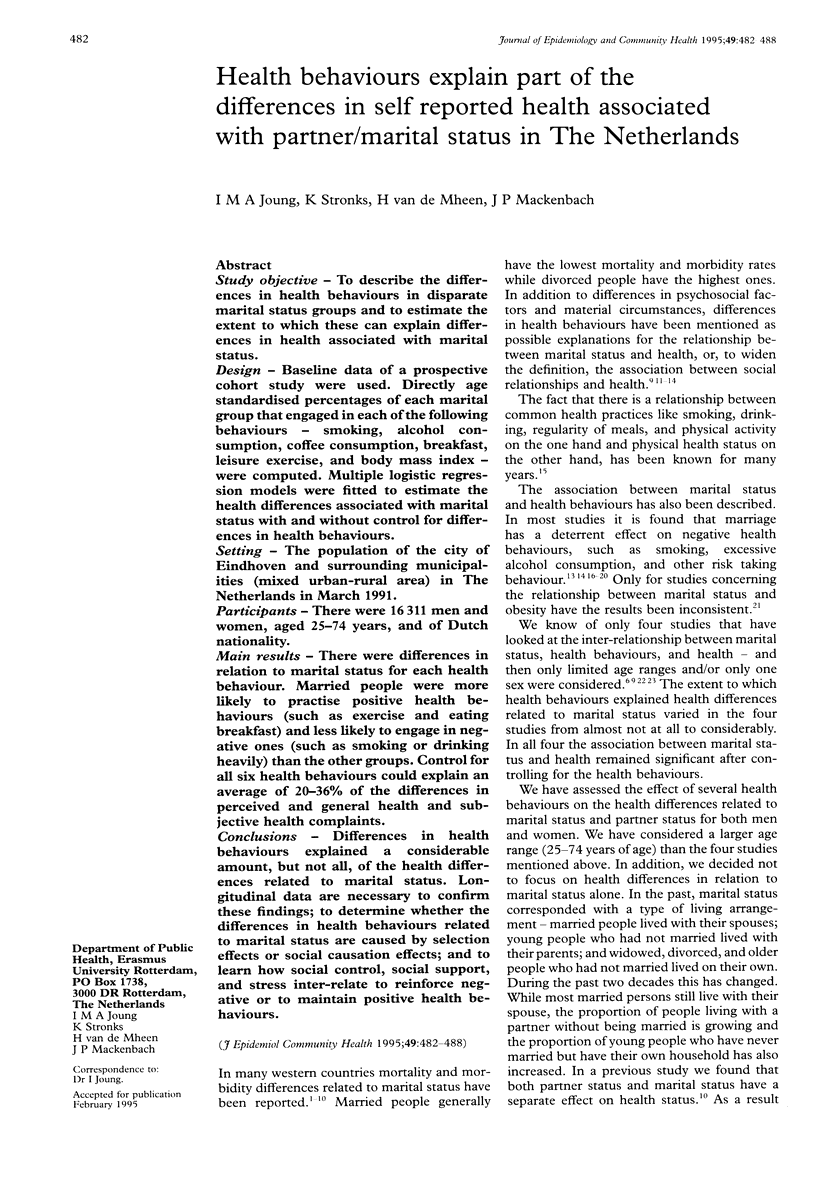
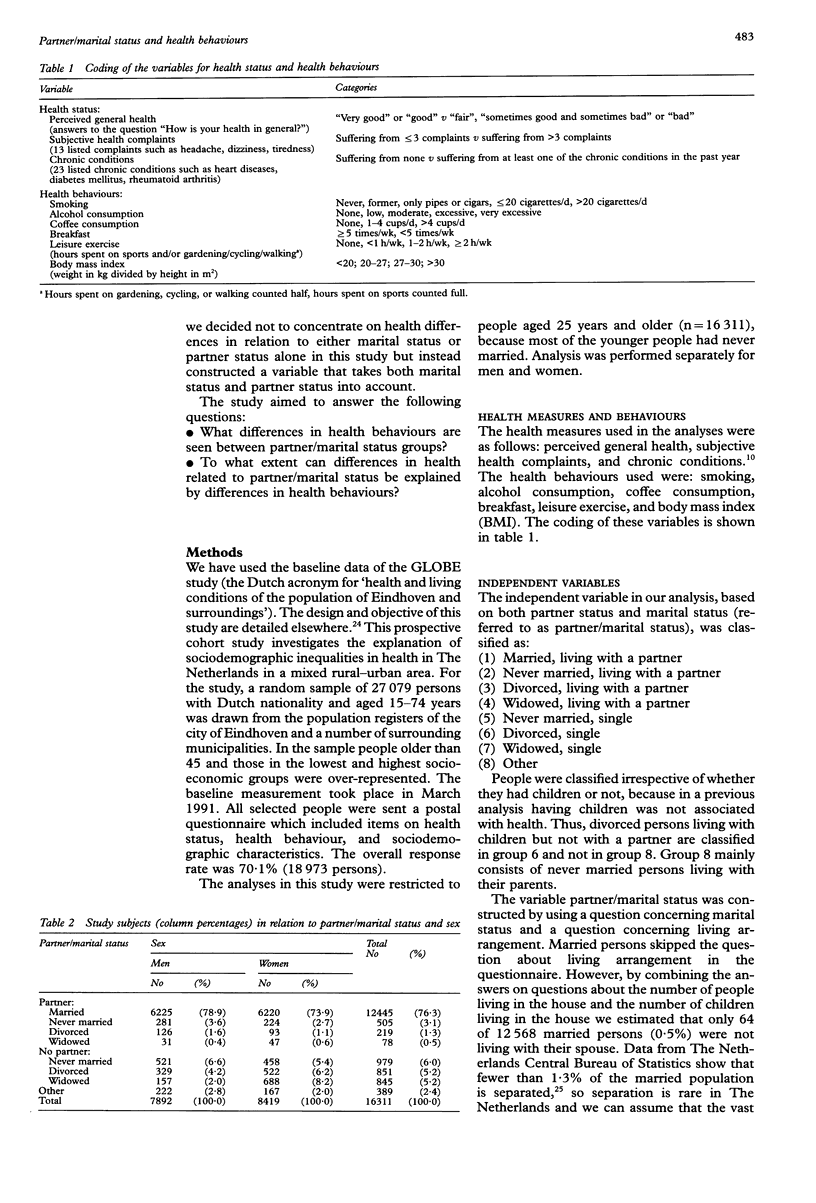
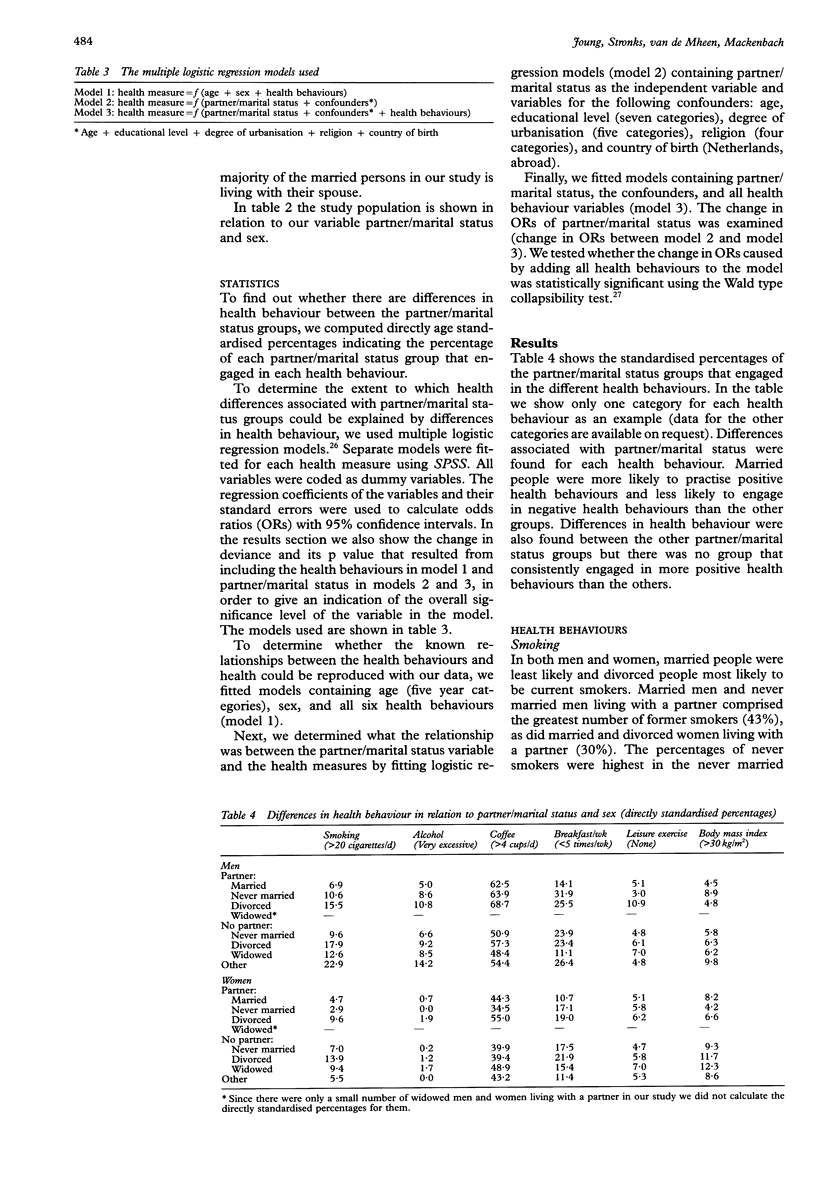
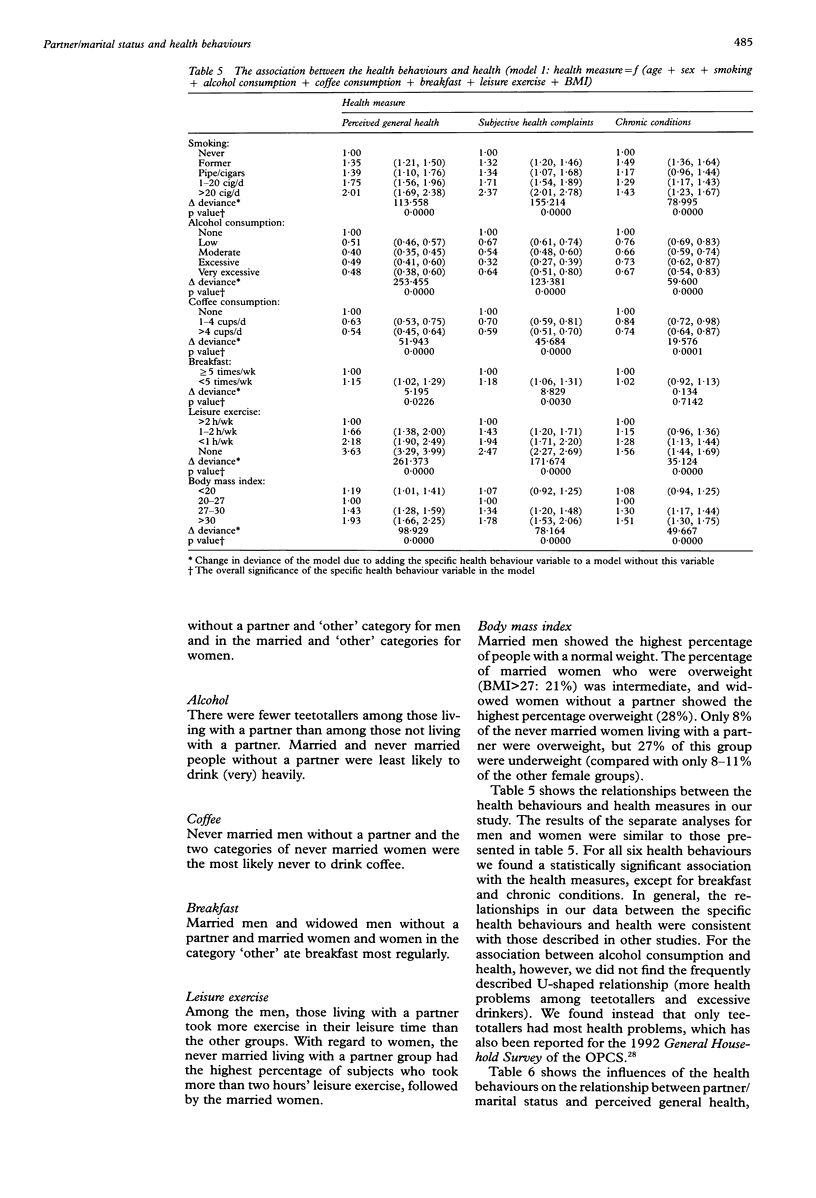


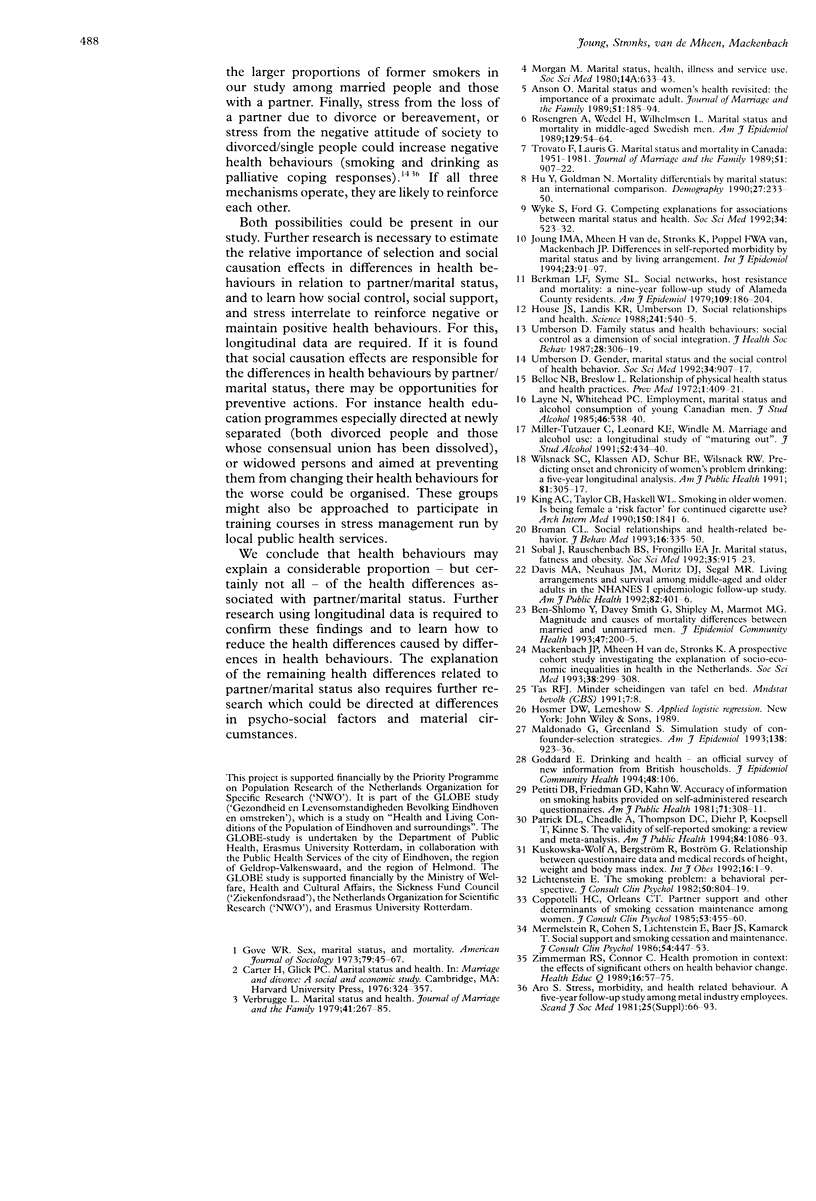
Selected References
These references are in PubMed. This may not be the complete list of references from this article.
- Belloc N. B., Breslow L. Relationship of physical health status and health practices. Prev Med. 1972 Aug;1(3):409–421. doi: 10.1016/0091-7435(72)90014-x. [DOI] [PubMed] [Google Scholar]
- Ben-Shlomo Y., Smith G. D., Shipley M., Marmot M. G. Magnitude and causes of mortality differences between married and unmarried men. J Epidemiol Community Health. 1993 Jun;47(3):200–205. doi: 10.1136/jech.47.3.200. [DOI] [PMC free article] [PubMed] [Google Scholar]
- Broman C. L. Social relationships and health-related behavior. J Behav Med. 1993 Aug;16(4):335–350. doi: 10.1007/BF00844776. [DOI] [PubMed] [Google Scholar]
- Coppotelli H. C., Orleans C. T. Partner support and other determinants of smoking cessation maintenance among women. J Consult Clin Psychol. 1985 Aug;53(4):455–460. doi: 10.1037//0022-006x.53.4.455. [DOI] [PubMed] [Google Scholar]
- Davis M. A., Neuhaus J. M., Moritz D. J., Segal M. R. Living arrangements and survival among middle-aged and older adults in the NHANES I epidemiologic follow-up study. Am J Public Health. 1992 Mar;82(3):401–406. doi: 10.2105/ajph.82.3.401. [DOI] [PMC free article] [PubMed] [Google Scholar]
- Goddard E. Drinking and health--an official survey of new information from British households. J Epidemiol Community Health. 1994 Apr;48(2):106–106. doi: 10.1136/jech.48.2.106. [DOI] [PMC free article] [PubMed] [Google Scholar]
- Gove W. R. Sex, marital status, and mortality. AJS. 1973 Jul;79(1):45–67. doi: 10.1086/225505. [DOI] [PubMed] [Google Scholar]
- House J. S., Landis K. R., Umberson D. Social relationships and health. Science. 1988 Jul 29;241(4865):540–545. doi: 10.1126/science.3399889. [DOI] [PubMed] [Google Scholar]
- Hu Y. R., Goldman N. Mortality differentials by marital status: an international comparison. Demography. 1990 May;27(2):233–250. [PubMed] [Google Scholar]
- Joung I. M., van de Mheen H., Stronks K., van Poppel F. W., Mackenbach J. P. Differences in self-reported morbidity by marital status and by living arrangement. Int J Epidemiol. 1994 Feb;23(1):91–97. doi: 10.1093/ije/23.1.91. [DOI] [PubMed] [Google Scholar]
- King A. C., Taylor C. B., Haskell W. L. Smoking in older women. Is being female a 'risk factor' for continued cigarette use? Arch Intern Med. 1990 Sep;150(9):1841–1846. doi: 10.1001/archinte.150.9.1841. [DOI] [PubMed] [Google Scholar]
- Layne N., Whitehead P. C. Employment, marital status and alcohol consumption of young Canadian men. J Stud Alcohol. 1985 Nov;46(6):538–540. doi: 10.15288/jsa.1985.46.538. [DOI] [PubMed] [Google Scholar]
- Lichtenstein E. The smoking problem: a behavioral perspective. J Consult Clin Psychol. 1982 Dec;50(6):804–819. doi: 10.1037//0022-006x.50.6.804. [DOI] [PubMed] [Google Scholar]
- Mackenbach J. P., van de Mheen H., Stronks K. A prospective cohort study investigating the explanation of socio-economic inequalities in health in The Netherlands. Soc Sci Med. 1994 Jan;38(2):299–308. doi: 10.1016/0277-9536(94)90399-9. [DOI] [PubMed] [Google Scholar]
- Maldonado G., Greenland S. Simulation study of confounder-selection strategies. Am J Epidemiol. 1993 Dec 1;138(11):923–936. doi: 10.1093/oxfordjournals.aje.a116813. [DOI] [PubMed] [Google Scholar]
- Mermelstein R., Cohen S., Lichtenstein E., Baer J. S., Kamarck T. Social support and smoking cessation and maintenance. J Consult Clin Psychol. 1986 Aug;54(4):447–453. doi: 10.1037//0022-006x.54.4.447. [DOI] [PubMed] [Google Scholar]
- Miller-Tutzauer C., Leonard K. E., Windle M. Marriage and alcohol use: a longitudinal study of "maturing out". J Stud Alcohol. 1991 Sep;52(5):434–440. doi: 10.15288/jsa.1991.52.434. [DOI] [PubMed] [Google Scholar]
- Morgan M. Marital status, health, illness and service use. Soc Sci Med Med Psychol Med Sociol. 1980 Dec;14A(6):633–643. doi: 10.1016/0160-7979(80)90068-5. [DOI] [PubMed] [Google Scholar]
- Patrick D. L., Cheadle A., Thompson D. C., Diehr P., Koepsell T., Kinne S. The validity of self-reported smoking: a review and meta-analysis. Am J Public Health. 1994 Jul;84(7):1086–1093. doi: 10.2105/ajph.84.7.1086. [DOI] [PMC free article] [PubMed] [Google Scholar]
- Petitti D. B., Friedman G. D., Kahn W. Accuracy of information on smoking habits provided on self-administered research questionnaires. Am J Public Health. 1981 Mar;71(3):308–311. doi: 10.2105/ajph.71.3.308. [DOI] [PMC free article] [PubMed] [Google Scholar]
- Rosengren A., Wedel H., Wilhelmsen L. Marital status and mortality in middle-aged Swedish men. Am J Epidemiol. 1989 Jan;129(1):54–64. doi: 10.1093/oxfordjournals.aje.a115124. [DOI] [PubMed] [Google Scholar]
- Umberson D. Family status and health behaviors: social control as a dimension of social integration. J Health Soc Behav. 1987 Sep;28(3):306–319. [PubMed] [Google Scholar]
- Umberson D. Gender, marital status and the social control of health behavior. Soc Sci Med. 1992 Apr;34(8):907–917. doi: 10.1016/0277-9536(92)90259-s. [DOI] [PubMed] [Google Scholar]
- Wilsnack S. C., Klassen A. D., Schur B. E., Wilsnack R. W. Predicting onset and chronicity of women's problem drinking: a five-year longitudinal analysis. Am J Public Health. 1991 Mar;81(3):305–318. doi: 10.2105/ajph.81.3.305. [DOI] [PMC free article] [PubMed] [Google Scholar]
- Wyke S., Ford G. Competing explanations for associations between marital status and health. Soc Sci Med. 1992 Mar;34(5):523–532. doi: 10.1016/0277-9536(92)90208-8. [DOI] [PubMed] [Google Scholar]
- Zimmerman R. S., Connor C. Health promotion in context: the effects of significant others on health behavior change. Health Educ Q. 1989 Spring;16(1):57–75. doi: 10.1177/109019818901600108. [DOI] [PubMed] [Google Scholar]


